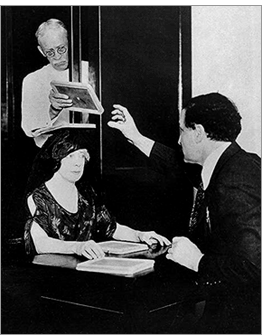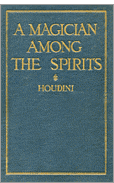
|
| |||
1910–1924 | 1925–1926 | 1927–1930 | 1931–1943 | MORE RECENT
HOUDINI BANISHES THE SPIRITS A Magician Records His Investigations of Spiritualistic Phenomena A MAGICIAN AMONG THE SPIRITS. By Houdini. Illustrated. 294pp. New York: Harper & Brothers. $4.
When such a man makes the [broad?] statement that after years of careful investigation he can find no evidence that the spirits of the dead communicate with the living or that the manifestations produced at spiritualistic séances are due to other than natural causes, his words are entitled to some consideration. And Houdini goes even further. He states most emphatically that he has never seen nor heard of any feat performed by a medium—or, if one prefers to have it so, by the spirits evoked by a medium—which could not be duplicated by a competent professional magician, provided he were permitted to work under the same conditions as those insisted upon by the mediums. And he cites a number of instances where such feats have been duplicated either by himself or by some other magician.
Houdini was fortunate enough to meet one of the Davenport brothers, Ira, long after the latter had retired from the stage. The two became friends, and Ira taught Houdini the famous Davenport rope tie, which Houdini, in turn, passes on to the reader, although it must be admitted that his description is so vague as to give no more than a general idea of the manner in which the trick was performed. Of more interest is Ira’s statement, quoted by Houdini, that the Davenport brothers not only did not receive any help from the spirits, but that they had never claimed to have received such help. This is a mere quibble, however, for in the very next breath Ira admitted that neither he nor his brother had ever publicly denied that they were in communication with spirits, and that they had permitted their lecturer, who was a firm believer in their mediumistic powers, to communicate that belief to their audiences. Ira’s explanation of this is that they found it more profitable to let the audience draw its own conclusions. Daniel Douglas Home, according to Houdini, was not only a fraud, but probably a thief as well. That he was never fully exposed was due to the fact that his séances were all private. He picked his audiences, excluding those who seemed unlikely to prove sufficiently credulous. From the testimony of those who witnessed his famous feat of floating out of the window of one room and into a window of an adjoining room, Houdini finds that it was performed under conditions which made deception very easy, and that the spectators probably imagined more than they saw. This tendency of those present at séances to assist in their own deception is well illustrated by a quotation from Houdini’s interview with Ira Davenport. Houdini says:
“The bells were loudly rung; the trumpets made knocks upon the floor, and the tambourine appeared running around the room, jingling with all its might. At the same time sparks were observed as if passing from south to west. Several persons exclaimed that they were touched by the instruments, which on one occasion became so demonstrative that one gentleman received a knock on the nasal organ which broke the skin and caused a few drops of blood to flow.” After I finished reading it Ira exclaimed: “Strange how people imagine things in the dark! Why, the musical instruments never left our hands, yet many spectators would have taken an oath that they heard them flying over their heads.” It might be supposed from the foregoing that Houdini has undertaken these investigations with the fixed purpose of disproving the claims of the spiritualists, but he assures us that this is not the case. He declares that he is willing, even eager, to find proof that the spirits of the departed do communicate with the living. There are those in the beyond from whom he would be glad to receive messages. He has, he tells us, made compacts with several dear friends and relatives to the effect that the one who first departed this life should make every effort to communicate with the other, but though several of these persons have since died, no word has come from any of them. He has attended séances and asked to be placed in communication with the spirits of these persons, and in some cases alleged messages have been given through the medium, but they were never of such a nature as to be convincing. Not one has been able to give the secret word or sign previously agreed upon between Houdini and the departed. Th erefore, in considering the claims of the spiritualists, he finds himself compelled to give the verdict “not proved.” It is a curious thing that, while Houdini declares the mediums to be nothing more than conjurers, and none of them not particularly skillful ones at that, some eminent believers in spiritualism declare that Houdini himself is a medium and that it is by the aid of the spirits that he is able to perform the feats that mystify his audiences. One of these is J. Hewat McKenzie, President of the British College of Psychic Science, from whose book, “Spirit Intercourse,” Houdini quotes:
In another part of his book, Mr. McKenzie elaborates this theory by giving a detailed description of Houdini’s famous tank trick in which he escapes from a locked iron tank completely filled with water. Mr. McKenzie stood over the tank while this trick was being performed, and he declares that “a great loss of physical energy was felt by him, such as is usually experienced by sitters in materializing séances.” He concludes by saying: “This startling manifestation of one of nature’s profoundest miracles was probably regarded by most of the audience as a very clever trick.” To this Houdini replies:
Among the subjects discussed by Houdini are spirit rappings, table tipping, slate writing, spirit photography, ectoplasm and other tricks of the mediums. Concerning ectoplasm he has little to say excepting that where test conditions are rigid the results are negative, but the other tricks are exposed at length, several methods being described by which each of them can be performed. Regarding the methods by which mediums are able to release themselves when tied, he is more reticent, probably because these tricks are a little too much in his own line. From his point of view it is not desirable that the public should be too well informed as to the modus operandi of tricks so nearly akin to his own. He needs those tricks in his business, and who can blame him for refusing to reveal the methods by which they are performed? This article is reproduced here only for educational purposes. Please do not copy the text or accompanying images for commercial use.
|

 Houdini’s book, “A Magician Among the Spirits,” is more than a record of his investigations of spiritualistic phenomena. It is a history of the spiritualistic movement in modern times. Beginning with the Fox sisters, he sketches briefly the careers of such noted figures as the Davenport brothers, Daniel Douglas Home, Ann O’Della Diss de Bar, Eusapia Palladino, Henry Slade and others who have won international fame as mediums. Not all of these were personally known to Houdini, but in the cases of those who were not he has made a careful investigation of the records of their activities, and he finds no reason to believe that the feats performed by them were anything but clever legerdemain. In regard to the Fox sisters, he quotes the confession signed by Margaret Fox Kane and published in The New York World Oct. 21, 1888. In this confession Mrs. Kane told how she and her sister first produced the mysterious rappings as a mischievous prank intended to mystify their mother. They succeeded so well that they became the talk of the neighborhood, and an older married sister, seeing the possibilities of their tricks, took them under her wing and carried them about the country to give exhibitions. Incidentally, this elder sister pocketed all the profits. Mrs. Kane further stated that the rappings were produced by purely mechanical means, which she explained.
Houdini’s book, “A Magician Among the Spirits,” is more than a record of his investigations of spiritualistic phenomena. It is a history of the spiritualistic movement in modern times. Beginning with the Fox sisters, he sketches briefly the careers of such noted figures as the Davenport brothers, Daniel Douglas Home, Ann O’Della Diss de Bar, Eusapia Palladino, Henry Slade and others who have won international fame as mediums. Not all of these were personally known to Houdini, but in the cases of those who were not he has made a careful investigation of the records of their activities, and he finds no reason to believe that the feats performed by them were anything but clever legerdemain. In regard to the Fox sisters, he quotes the confession signed by Margaret Fox Kane and published in The New York World Oct. 21, 1888. In this confession Mrs. Kane told how she and her sister first produced the mysterious rappings as a mischievous prank intended to mystify their mother. They succeeded so well that they became the talk of the neighborhood, and an older married sister, seeing the possibilities of their tricks, took them under her wing and carried them about the country to give exhibitions. Incidentally, this elder sister pocketed all the profits. Mrs. Kane further stated that the rappings were produced by purely mechanical means, which she explained.